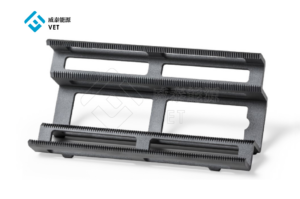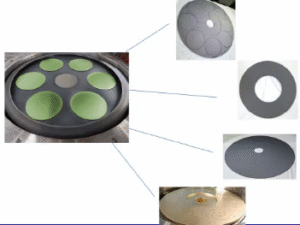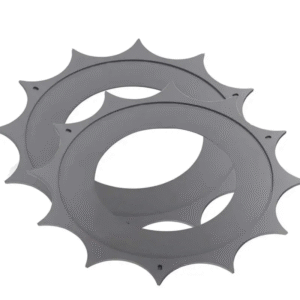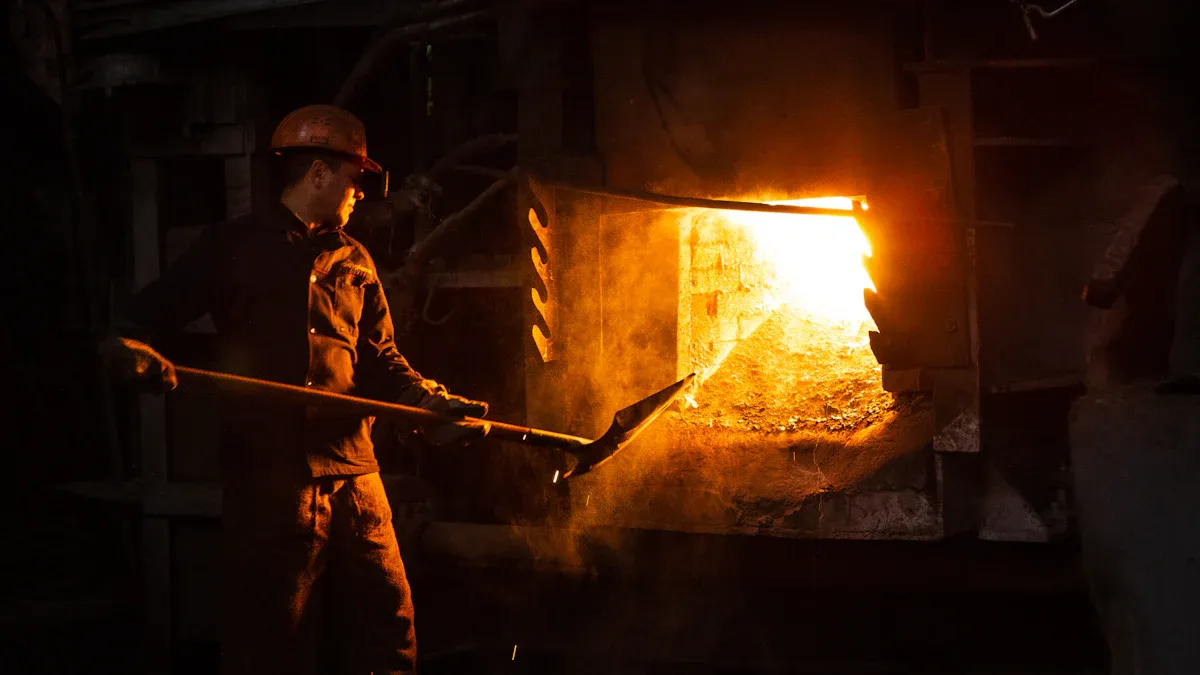
Graphite susceptors are essential components in high-volume metallurgical furnace operations, providing exceptional thermal performance and dependable heat management. Their resilience to high temperatures and reactive environments makes them crucial for industries demanding precision and durability. Ningbo VET Energy Technology Co., Ltd utilizes cutting-edge advancements, including CVD TAC COATING, TAC COATING, CVD SIC COATING, and SIC COATING, to develop innovative solutions. These technologies enhance the efficiency of graphite susceptors, minimizing material waste and optimizing energy consumption. Their EPI susceptor technology, integrated with these coatings, has proven to deliver substantial cost savings and scalability, particularly in applications such as 5G chip manufacturing.
Key Takeaways
- Graphite parts help furnaces work better by managing heat well.
- Picking good graphite, like isotropic graphite, spreads heat evenly.
- Coated graphite, with SiC or TAC, lasts longer and costs less to fix.
- Checking graphite often keeps it strong and working reliably.
- New methods, like 3D printing, make custom designs and save materials.
Key Design Principles for Graphite Susceptors
Optimizing Thermal Conductivity
Thermal conductivity plays a pivotal role in the performance of a graphite susceptor. High thermal conductivity ensures efficient heat transfer, which is essential for maintaining consistent temperatures in metallurgical furnace operations. To achieve this, manufacturers focus on selecting graphite materials with superior thermal properties. Isotropic graphite, for instance, offers uniform thermal conductivity in all directions, making it a preferred choice for high-volume applications.
Design modifications also contribute to optimizing thermal conductivity. Engineers often incorporate features such as strategically placed cooling channels or enhanced surface finishes to improve heat dissipation. Ningbo VET Energy Technology Co., Ltd excels in this area by leveraging advanced coating technologies like CVD SIC COATING. These coatings not only enhance thermal conductivity but also provide additional protection against wear, ensuring long-term performance.
Enhancing Durability for High-Volume Operations
Durability is a critical factor for graphite susceptors used in high-volume operations. These components must withstand extreme temperatures, mechanical stress, and exposure to reactive environments without compromising their structural integrity. To enhance durability, manufacturers prioritize material selection and innovative design approaches.
Coated graphite materials, such as those developed by Ningbo VET Energy Technology Co., Ltd, offer exceptional resistance to oxidation and chemical degradation. Coatings like TAC COATING and SIC COATING create a protective barrier, extending the lifespan of the susceptor. Additionally, precise machining techniques ensure that the susceptor’s geometry minimizes stress concentrations, further improving its durability. This combination of robust materials and meticulous design enables graphite susceptors to perform reliably in demanding industrial settings.
Achieving Uniform Heat Distribution
Uniform heat distribution is essential for maintaining process consistency and product quality in metallurgical furnaces. Uneven heating can lead to thermal stresses, material defects, and energy inefficiencies. To address this, manufacturers focus on both material properties and design enhancements.
The use of isotropic graphite, known for its consistent thermal diffusivity, significantly contributes to uniform heat distribution. Advanced testing methods, such as those conducted with an improved laser flash apparatus, have demonstrated the effectiveness of isotropic graphite in achieving minimal temperature variations. These tests, performed at temperatures up to 3000 °C, validate the importance of material selection in optimizing heat distribution.
Design modifications also play a crucial role. Adjustments to the susceptor’s geometry and the integration of efficient cooling systems help maintain consistent temperatures across the component. Ningbo VET Energy Technology Co., Ltd incorporates these principles into its designs, ensuring that their graphite susceptors deliver reliable performance in high-volume operations.
Material Selection for Graphite Susceptors
Comparing Synthetic and Natural Graphite
The choice between synthetic and natural graphite significantly impacts the performance and cost-effectiveness of a graphite susceptor. Synthetic graphite, produced through high-temperature processing of carbon materials, offers superior purity and consistency. Its uniform structure ensures predictable thermal and mechanical properties, making it ideal for applications requiring precision and reliability. Industries often prefer synthetic graphite for high-volume metallurgical furnace operations due to its ability to withstand extreme temperatures and resist chemical reactions.
Natural graphite, derived from mined ore, provides a more cost-effective alternative. While it exhibits good thermal conductivity and lubricity, its properties can vary depending on the source and processing methods. This variability may limit its use in applications demanding tight tolerances. However, for less demanding environments, natural graphite can deliver satisfactory performance at a lower cost. Manufacturers must carefully evaluate operational requirements to determine the most suitable option.
Tip: Synthetic graphite is often the better choice for critical applications, while natural graphite can reduce costs in less stringent scenarios.
Cost-Performance Analysis of Graphite Grades
Graphite grades vary in terms of density, grain size, and purity, all of which influence their performance and cost. High-density grades, characterized by fine grain structures, provide excellent mechanical strength and thermal stability. These properties make them suitable for high-stress environments, such as those found in metallurgical furnaces. However, their production involves complex processes, leading to higher costs.
Medium-density grades strike a balance between performance and affordability. They offer adequate thermal conductivity and durability for many industrial applications. Low-density grades, while less expensive, may lack the robustness required for high-volume operations. Manufacturers must weigh the trade-offs between cost and performance to select the optimal grade for their needs.
The expertise of companies like Ningbo VET Energy Technology Co., Ltd plays a crucial role in this decision-making process. Their advanced material analysis and customization capabilities ensure that clients receive graphite susceptors tailored to their specific requirements.
| Graphite Grade | Key Properties | Typical Applications |
|---|---|---|
| High-Density | High strength, thermal stability | High-stress furnace components |
| Medium-Density | Balanced performance and cost | General industrial use |
| Low-Density | Cost-effective, less durable | Low-demand environments |
Benefits of Coated Graphite Materials
Coated graphite materials offer enhanced performance and longevity, making them a valuable choice for demanding industrial applications. Coatings such as CVD SIC and TAC provide a protective layer that resists oxidation, chemical corrosion, and mechanical wear. These properties are particularly beneficial in high-temperature environments, where uncoated graphite may degrade over time.
The application of coatings also improves thermal conductivity and surface hardness, further optimizing the performance of the graphite susceptor. For instance, Ningbo VET Energy Technology Co., Ltd employs advanced coating technologies to create products that deliver consistent results under challenging conditions. Their coated graphite materials not only extend the lifespan of susceptors but also reduce maintenance costs, contributing to overall operational efficiency.
Note: Coated graphite materials represent a long-term investment, offering significant cost savings through reduced downtime and extended service life.
Manufacturing Techniques for Cost-Effective Graphite Susceptors
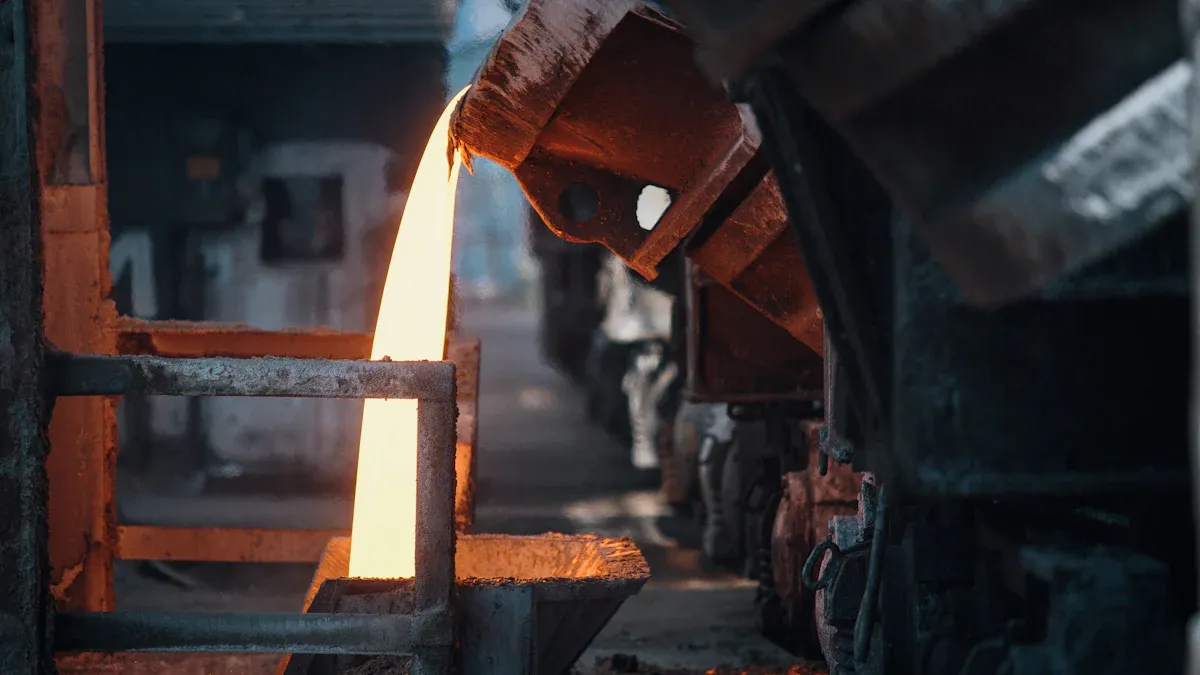
Traditional Machining Methods
Traditional machining methods remain a cornerstone in the production of graphite susceptors. Techniques such as milling, turning, and grinding allow manufacturers to achieve precise dimensions and smooth surface finishes. These processes ensure the susceptor’s compatibility with high-volume furnace operations, where accuracy is critical. High-speed CNC machines enhance productivity by reducing cycle times and improving repeatability. Ningbo VET Energy Technology Co., Ltd employs advanced machining technologies to deliver graphite susceptors with superior quality and reliability.
The integration of coating technologies, such as CVD SIC COATING, further refines the machining process. Coatings applied during or after machining enhance the susceptor’s thermal conductivity and durability. This combination of traditional methods and modern innovations ensures cost-effective production without compromising performance.
Additive Manufacturing for Customization
Additive manufacturing, commonly known as 3D printing, has revolutionized the customization of graphite susceptors. This technique enables the creation of complex geometries that traditional machining cannot achieve. Manufacturers can design susceptors tailored to specific furnace configurations, optimizing heat distribution and energy efficiency.
Layer-by-layer construction minimizes material waste, making additive manufacturing an environmentally friendly option. Ningbo VET Energy Technology Co., Ltd leverages this technology to produce bespoke graphite susceptors for industries like semiconductor manufacturing. Their approach ensures that each susceptor meets the unique demands of high-volume operations while maintaining cost-effectiveness.
Tip: Additive manufacturing allows rapid prototyping, reducing lead times and enabling faster product development cycles.
Minimizing Waste in Production Processes
Waste reduction is a critical aspect of cost-effective manufacturing. Efficient material utilization during machining and additive processes lowers production costs and supports sustainability goals. Manufacturers achieve this by optimizing cutting paths, reusing scrap materials, and implementing automated systems for precision control.
Advancements in manufacturing techniques, particularly in the semiconductor sector, contribute significantly to waste minimization. Automation and increased precision reduce errors, ensuring that every graphite susceptor meets stringent quality standards. Ningbo VET Energy Technology Co., Ltd incorporates these practices into their production workflows, delivering high-performance susceptors while minimizing environmental impact.
Note: Sustainable manufacturing practices not only reduce costs but also align with industry trends toward eco-friendly operations.
Real-World Applications of Graphite Susceptor Designs
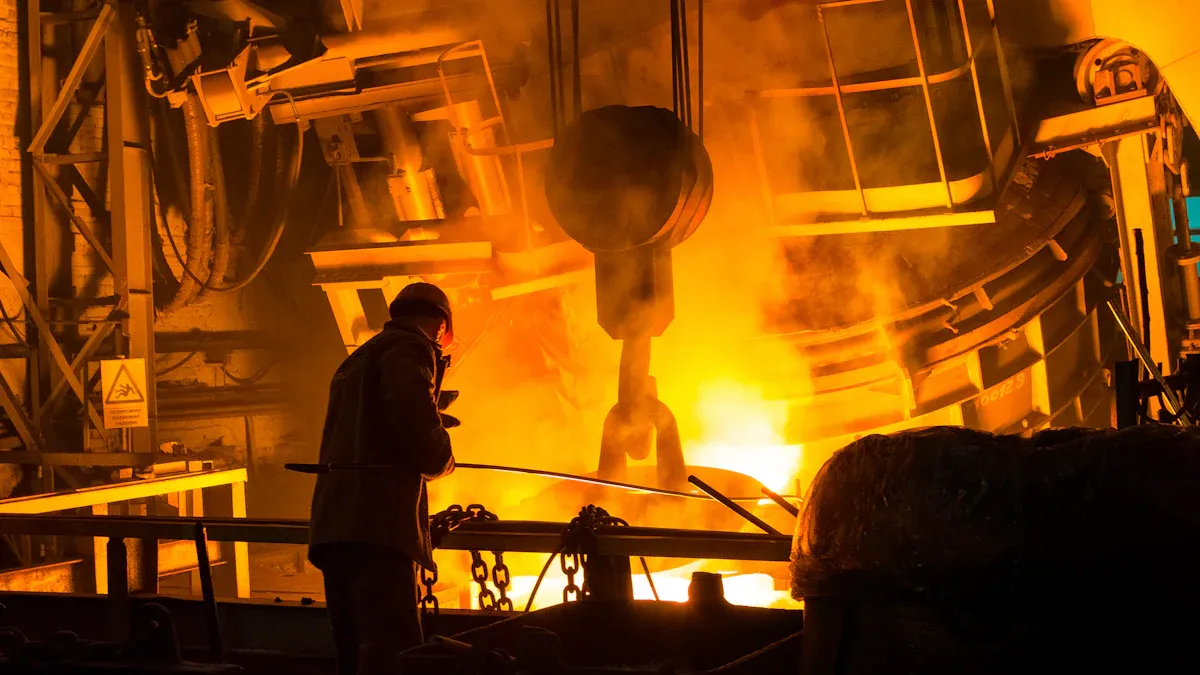
Case Studies from High-Volume Metallurgical Furnaces
Graphite susceptors have demonstrated their versatility and efficiency across various high-volume metallurgical furnace operations. Industries such as steel production and semiconductor manufacturing rely on these components to achieve precise temperature control and consistent heat distribution. In steelmaking, graphite susceptors ensure uniform heating during alloy formation, reducing defects and enhancing product quality. Semiconductor manufacturers benefit from their ability to maintain stable thermal environments, which is critical for producing high-performance chips. Ningbo VET Energy Technology Co., Ltd has collaborated with leading manufacturers to implement advanced susceptor designs, showcasing their adaptability in demanding industrial applications.
Cost Savings Through Optimized Designs
Optimized graphite susceptor designs contribute significantly to reducing operational costs. Enhanced thermal conductivity minimizes energy consumption by improving heat transfer efficiency. Uniform heat distribution reduces waste by ensuring consistent processing outcomes, lowering the need for rework. Coated graphite materials, such as those developed by Ningbo VET Energy Technology Co., Ltd, extend the lifespan of susceptors, reducing replacement frequency and maintenance expenses. Industries adopting these designs report substantial cost savings, enabling them to allocate resources to other critical areas of production.
Industry Insights from Ningbo VET Energy Technology Co., Ltd
Ningbo VET Energy Technology Co., Ltd has pioneered advancements in graphite susceptor technology, delivering tailored solutions for diverse industries. Their expertise in SiC coatings has proven effective in applications ranging from aerospace to solar energy.
| Industry | Application Description | Outcome |
|---|---|---|
| Aerospace | Customized SiC coating thickness for turbine components to manage thermal cycling. | Enhanced resistance to thermal stress, extending operational lifespan of components. |
| Solar Energy | SiC coatings on graphite susceptors in photovoltaic cell production. | Improved heat distribution, reduced energy consumption, and increased production output. |
These innovations highlight the company’s commitment to addressing industry-specific challenges through cutting-edge technology. Their graphite susceptor designs not only improve operational efficiency but also align with sustainability goals, making them a preferred partner for high-volume furnace operations.
Maintenance Strategies for Graphite Susceptors
Preventative Maintenance Practices
Preventative maintenance ensures the long-term reliability of graphite susceptors in high-volume furnace operations. Regular inspections and cleaning routines help identify potential issues before they escalate into costly failures. Industries adhering to global standards, such as IATF 16949:2016 and SEMI F47, have demonstrated the importance of maintaining impurity levels within acceptable limits. For instance, non-compliance with these standards has led to significant consequences, including multiyear contract losses and downtime costs exceeding $1 million.
| Standard | Industry | Impurity Level | Consequence of Non-Compliance |
|---|---|---|---|
| IATF 16949:2016 | Automotive | < 50 ppm | Loss of multiyear contracts (e.g., Panasonic’s vendor termination) |
| SEMI F47 | Semiconductor | N/A | Downtime costs exceeding $1 million due to impurity events |
| GB/T 3521-2023 | Battery-grade graphite | ≤ 10 ppm | Recall of materials (e.g., CATL’s 2023 recall) |
By implementing preventative measures, manufacturers can minimize downtime, maintain compliance, and extend the operational lifespan of their susceptors.
Addressing Common Wear and Tear
Graphite susceptors often face wear and tear due to prolonged exposure to extreme temperatures and reactive environments. Common issues include surface oxidation, cracking, and material degradation. Addressing these problems requires timely interventions, such as applying protective coatings or replacing worn components. Coatings like SiC or TAC, offered by Ningbo VET Energy Technology Co., Ltd, provide an effective barrier against oxidation and chemical damage.
Routine maintenance schedules should include visual inspections and thermal performance tests. These practices ensure that any signs of wear are promptly addressed, preventing further damage and maintaining the susceptor’s efficiency in high-volume operations.
Maximizing Lifespan with Regular Inspections
Regular inspections play a crucial role in maximizing the lifespan of graphite susceptors. These inspections should focus on identifying structural weaknesses, such as micro-cracks or uneven wear patterns. Advanced diagnostic tools, including thermal imaging and ultrasonic testing, can detect hidden defects that may compromise performance.
Industries that prioritize regular inspections benefit from reduced replacement costs and improved operational efficiency. Ningbo VET Energy Technology Co., Ltd emphasizes the importance of these practices, offering tailored maintenance solutions to ensure optimal performance. By combining preventative maintenance, timely repairs, and thorough inspections, manufacturers can significantly enhance the durability and reliability of their graphite susceptors.
Cost-effective graphite susceptor designs play a pivotal role in enhancing furnace efficiency and reducing operational costs. By adhering to key design principles, selecting optimal materials, employing advanced manufacturing techniques, and implementing robust maintenance strategies, industries can achieve superior performance and longevity.
The benefits of these designs are evident in their ability to meet the growing demands of advanced industries. The table below highlights key performance indicators that underscore their value:
| Key Performance Indicator | Description |
|---|---|
| Market Growth Projections | The graphite segment is expected to maintain a significant market share due to increasing demand for advanced electronic components. |
| Material Advantages | Graphite offers high thermal conductivity, stability at elevated temperatures, and resistance to harsh chemical environments. |
| Applications | Preferred in semiconductor and electronics industries for precise temperature control and uniform heat distribution. |
Ningbo VET Energy Technology Co., Ltd continues to lead the way with innovative solutions tailored to high-volume operations. Their expertise ensures that industries can optimize furnace performance while achieving sustainability goals.
Tip: Explore Ningbo VET Energy Technology Co., Ltd’s cutting-edge graphite susceptor solutions to unlock new levels of efficiency and reliability.
FAQ
What are the primary advantages of using graphite susceptors in metallurgical furnaces?
Graphite susceptors excel in thermal conductivity, durability, and resistance to extreme temperatures. These properties ensure efficient heat transfer, uniform temperature distribution, and long-term reliability, making them indispensable for high-volume industrial operations.
How do coatings like SiC and TAC improve graphite susceptor performance?
Coatings such as SiC and TAC enhance oxidation resistance, chemical stability, and surface hardness. These improvements extend the lifespan of susceptors and optimize their performance in high-temperature environments.
Can graphite susceptors be customized for specific industrial needs?
Yes, manufacturers like Ningbo VET Energy Technology Co., Ltd use advanced techniques, including additive manufacturing, to create bespoke designs. These customizations ensure compatibility with unique furnace configurations and operational requirements.
How often should graphite susceptors undergo maintenance?
Regular inspections, ideally every few months, are recommended. Preventative maintenance practices, such as cleaning and applying protective coatings, help identify wear early and extend the susceptor’s operational life.
Why is material selection critical for graphite susceptors?
Material selection determines the susceptor’s thermal, mechanical, and chemical properties. High-purity synthetic graphite offers superior performance for demanding applications, while natural graphite provides a cost-effective alternative for less stringent environments.
Tip: Consult experts like Ningbo VET Energy Technology Co., Ltd to select the best material for your specific application.


